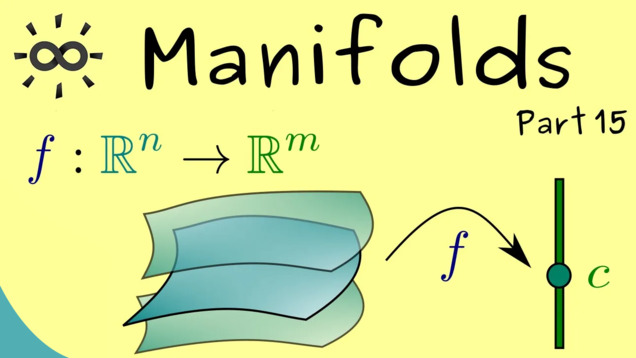
-
Title: Regular Value Theorem in $\mathbb{R}^n$
-
Series: Manifolds
-
YouTube-Title: Manifolds 15 | Regular Value Theorem in ℝⁿ
-
Bright video: https://youtu.be/tm4FeIz4Cas
-
Dark video: https://youtu.be/I9cXeqaOniM
-
Quiz: Test your knowledge
-
Dark-PDF: Download PDF version of the dark video
-
Print-PDF: Download printable PDF version
-
Thumbnail (bright): Download PNG
-
Thumbnail (dark): Download PNG
-
Subtitle on GitHub: mf15_sub_eng.srt missing
-
Timestamps (n/a)
-
Subtitle in English (n/a)
-
Quiz Content
Q1: Let $f: \mathbb{R} \rightarrow \mathbb{R}^2$ be a $C^1$-function. Which claim is correct?
A1: All the points $x \in \mathbb{R}$ are critical points of $f$.
A2: All the points $x \in \mathbb{R}^2$ are critical points of $f$.
A3: There are no critical points of $f$.
A4: There is only one critical point of $f$.
Q2: Let $f: \mathbb{R}^2 \rightarrow \mathbb{R}^2$ be the function given by $f(x) = x$. Which claim is correct?
A1: There are no critical points of $f$.
A2: All the points $x \in \mathbb{R}^2$ are critical points of $f$.
A3: There are no regular values of $f$.
A4: There is only one critical point of $f$.
Q3: Let $f: \mathbb{R}^n \rightarrow \mathbb{R}^m$ be a $C^\infty$-function. What is correct formulation of the regular value theorem?
A1: If $c$ is a regular value of $f$, then $f^{-1}[{ c } ]$ is an $(n-m)$-dimensional submanifold of $\mathbb{R}^n$.
A2: If $f^{-1}[{ c } ]$ is an $(n-m)$-dimensional submanifold of $\mathbb{R}^n$, then $c$ is a regular value of $f$.
A3: If $f^{-1}[{ c } ]$ is a critical point of $f$, then $c$ is a regular value of $f$.
Q4: Let $f: \mathbb{R}^2 \rightarrow \mathbb{R}$ be given by $f(x,y) = x^2 + y^2 - 1$. Is $f^{-1}[{ 0 } ]$ a submanifold?
A1: Yes, it is by the regular value theorem.
A2: No, 0 is not a regular value.
A3: No, the function is not well-defined.
A4: One needs more information.